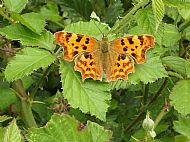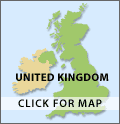Butterflies
All the Butterfly species shown occur on the Middlewick Ranges, some are common, others are listed as endangered or vunerable.Conservation status shown with each species.
It will be seen that I refer to the UK BAP, this means the Government run UK Bio- Diversity Action Plan, an inititive to protect the habitats and species, I could add that it seems a bit strong as the MOD are forced to sell this land due to government policy. Development would obliterate the very species they claim to protect.
 Common Blue Butterfly The Common Blue Butterfly, this one is a female. Status, least concern. |
|
 White Letter Hairstreak Butterfly The White letter Hairstreak Butterfly, sexes are simular. Status red, endangered. |
|
 Small Tortoiseshell Butterfly One of the first to awaken from hibernation in the Spring. Status, in decline. |
|
 White Admiral Butterfly. The silvery appearance of the White Admiral will be easily recognised in July as it glides past. Now it seems to have extended its range to the Middlewick area. Status, vunerable and can stand no more pressure on its population. |
|
 Holly Blue. The Holly Blue , plentifull on Middlewick' this one is a female. Status,least concern,common. |
|
 Comma Butterfly. A somewhat ragged looking species, it gets the name Comma from the white mark on the underside. Status, least concern but a slight decline in recent years although this may be due to under recording, even common species should be recorded to monitor the population. |
|
 Brown Argus. The size of a Blue butterfly, a small colony exists in the area. It seems this one had a narrow escape from a bird. Status, common.
|
|
 Brown Argus underside. The underside of a Brown Argus. |
|
 Peacock Butterfly. Everyone must have seen the Peacock Butterfly, the eye markings are said to deter predators but to little avail with this one which seems to have narrowly escaped a bird attack.Status common. |
|
 Small Copper Butterfly. The Small Copper Butterfly, shows up around April and remains on the wing well into October, maybe November if the weather is mild enough. Status, common but slight decline. |
|
 Green Veined White. The Green Veined White, abundant on the Wick throughout the summer. Status, common. |
|
 Common Blue. The brown variation of the Common Blue. |
|
 Red Admiral Butterfly. A migrant from North Africa but can now hibernate and survive the winter in the UK,this photo was taken in March and I have seen them in February, not bad as fifty years ago May was the time they appeared. Status common.
|
|
 Small Heath Butterfly. Small Heath, plenty in the area we are concerned with but according to UK BAP it has suffered a 62% decline in numbers in the past 20 years,they list it as a priority species of principle importance. |
|
 Speckled Wood Butterfly. May be seen from late Spring onwards, a shade loving butterfly and it will be on the wing in light cloud and hazy sunshine.
Status, Common. |
|
 Ringlet Butterfly. A fairly common species on the wick. |
|
 Small Skipper Butterfly. Common on the Wick, very simular in appearance to the Essex Skipper. |
|
 Large Skipper Butterfly. Present in small numbers on the Wick. |
|
 Meadow Brown Butterfly. Present in large numbers, no fun being the grub but is for a number of species. |
|
 Gate Keeper Butterfly. Common on the Wick, as it is everywhere, but an important link in the food chain. |
|
 Peacock Butterfly Larva. The somewhat handsome larva of the Peacock Butteryfly.
|
|
 Purple Hairstreak Butterfly. This species will do little to further our cause as it is probably the commonest Hairstreak in the UK, but always a pleasure to see. |
|
 Green Hairstreak This little butterfly is around the size of the blue butterflies, there is a sprinkling of them on the Wick late April-May. |
|
| |
























